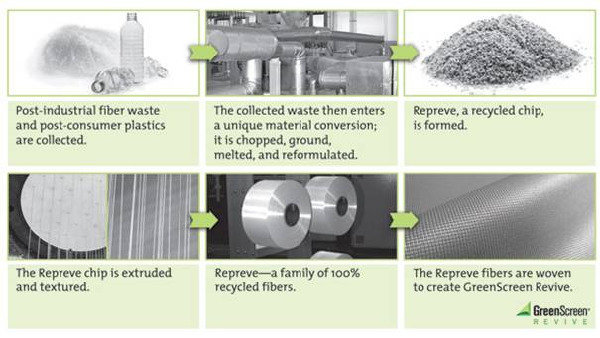Window Coverings are one of the most effective ways towards energy efficiencies in buildings. Here is a guide that covers some important issues. Decorating with Fabric is GSA Advantage vendor. GSA Award #GS-03F-0095X – Small Business.
What is a Green Window?
It is a window in a residential, commercial or institutional facility that is treated by a window covering to prevent the loss of heat in winter and to filter out solar heat gain in summer months with sustainable products and ideas.
LEED opportunities for Window Coverings address a few areas:
Sustainable Sites
Credit 8, Light Pollution Reduction:
This credit has two parts, interior lighting control and exterior lighting control. Both parts must be satisfied to earn this credit. The interior lighting portion of this credit has two compliance options to choose from. Draper’s motorized shades, used in conjunction with Draper controls, can meet the option 2 compliance method for the interior lighting portion of the credit:
“All exterior openings, such as windows, must have shielding that can be automatically controlled and programmed to close from 11:00 p.m. to 5:00 a.m. Shielding options include automatic shades that have less than 10% transmittance. An example is a timer-controlled automated rolling shade with the appropriate light transmittance.”
Credit 9, Tenant Design and Construction Guidelines:
This credit is only for LEED Core & Shell (CS). The intent of this credit is to educate tenants on sustainable design for their tenant improvement build-out. One of the LEED 2009 credits to be addressed is Daylighting and Views. Window shades are an excellent choice to control glare when pursuing a daylighting strategy.
“So that tenants can optimize daylighting, a LEED for Core & Shell commercial office building design should consider floor-to-ceiling heights, the bay size, the type of glazing, and the depth of occupied spaces. Daylight shelves and glare control devices should also be considered.”
Credit 9, Site Master Plan
This credit is only for LEED SCHOOLS. The credit requires that 4 out of 7 credits be achieved. One of the credits is SS Credit 8: Light Pollution Reduction. The effects of Decorating with Fabric’s window shades on this credit are described above.
Energy & Atmosphere
Prerequisite 1- Fundamental Commissioning of Building Energy Systems:
To achieve LEED certification all prerequisites must be satisfied. This prerequisite requires a commissioning authority (CxA) to take a number of fundamental commissioning steps. Commissioning activities must be completed for lighting and daylighting controls. Decorating with Fabric can provide information about our window shade controls.
“Commissioning process activities must be completed for the following energy-related systems, at a minimum (if they are installed as part of the core and shell project)…lighting and daylighting controls…”
Prerequisite 2- Minimum Energy Performance
To achieve LEED certification all prerequisites must be satisfied. This prerequisite requires a 10% improvement (55% for existing buildings) compared with the baseline building performance rating. Decorating with Fabric’s motorized shades, operating based on the sun’s movement through automated controls such as the Decorating with Fabric’s Digital Network, will increase energy efficiency. Motorized shades should be included in the energy model.
Credit 1- Optimize Energy Performance
This credit is worth up 19 points. The minimum energy cost savings percentage is 12% for new buildings and 8% for existing building renovations. Additional points (up to 19) can be awarded for greater percentage savings. Decorating with Fabric’s motorized shades, operating based on the sun’s movement through automated controls such as the Decorating with Fabric’s Digital Network, will increase energy efficiency. Motorized window shades should be included in the energy model.
“Manually controlled interior shading devices such as blinds and curtains should not be modeled. Automatically controlled interior shading devices can be modeled…”
Credit 3- Enhanced Commissioning
There are 12 steps involved in the enhanced commissioning process. By providing information and documentation, Decorating with Fabric can assist with Steps 9 and 10. Step 9 specifies that a systems manual be developed for all commissioned systems. Daylighting controls were a requirement Prerequisite 1, Fundamental Commissioning. Step 10 requires training on commissioned systems for operating personnel and building occupants. Related credits include: Sustainable Sites Credit 8: Light Pollution Reduction; and Energy and Atmosphere Credit 1: Optimize Energy Performance. Page 3 of 5
Materials & Resources
Credit 3- Materials Reuse
This credit considers the reuse of materials on the project. Decorating with Fabric’s window shades are in Division 12, which can possibly be counted in this credit. It is possible that Decorating with Fabric’s window shades salvaged for reuse could contribute towards this credit.
Credit 4- Recycled Content
This credit considers the recycled content of materials on the project. Decorating with Fabric’s window shades are in Division 12 which can possibly be counted in this credit. Decorating with Fabric’s uses components with recycled content. It is possible that Decorating with Fabric’s window shades could contribute to this credit. Please contact Decorating with Fabric for recycled content information.

Credit 5-Regional Materials
This credit considers products which have been extracted, harvested and manufactured within 500 miles of the project. Decorating with Fabric’s window shades are in Division 12 which can possibly be counted in this credit.
Indoor Environmental Quality
The intent of this credit is to provide building occupants with a connection between indoor spaces and the outdoors through the introduction of daylight and views.

